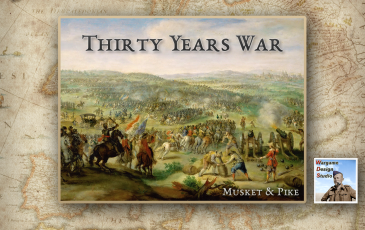048_Lutzen - Salvo Variant - WDS Thirty Years War

64f8a9520a0c004fd5ef.jpg) 0 - 0 - 0
0 - 0 - 0
435be480296def0cb8f9.jpg)
| Rating: | 0 (0) |
| Games Played: | 0 |
| SM: | 2 |
| Turns: | 24 |
| Type: | Stock |
| First Side: | Anti-Imperialist (TYW) |
| Second Side: | Imperialist (TYW) |
Date: 16th November 1632 - Size: Medium - Location: Lutzen, Saxony-Anhalt
Scenario Briefing: The Battle of Lutzen - The repulse of the reckless Gustavus Adolphus' army at Alte Veste had not inflicted heavy losses but it had shattered the myth of Swedish invincibility, causing more than 10,000 troops to desert the Swedish king and forcing him to retreat from Nuremberg. However, the still over-confident Gustavus believed that the enemy would soon go into winter quarters, so he marched southwards with the intention of reducing Swabia before winter. Meanwhile, Wallenstein was determined to attack Saxony, with the aim of forcing Gustavus to march to his ally's assistance or else have Johann Georg sue for peace or even be forced to switch sides. This would seriously risk communications back to northern Germany and Sweden being severed. Gustavus' initial response was to invade Bavaria in the expectation that this would draw Wallenstein southwards. It did cause Maximilian's 6,000 Bavarians and Aldringer' 8000 strong corps to leave Wallenstein, but Wallenstein himself continue his march against Saxony, where he split his army into corps and prepared to go into winter quarters until the sudden approach of Gustavus' army compelled him to regroup his forces and summon Pappenheim to his assistance.
Wallenstein selected Lutzen as a good location to fight a defensive battle against the slightly larger Swedish army. The marshy Muhlgraben protecting his right flank would be difficulty to cross, especially for cavalry, while the left flank was at least partially secured by a large drainage ditch called the Flossgraben. The village of Lutzen - which would be set on fire to prevent troops moving through it and also to reduce visibility - also had an old castle which could be garrisoned. In center of the Imperialist position, a sunken road would form an awkward obstacle for cavalry to cross, particularly after Wallenstein had entrenched musketeers to defend it. Near Lutzen and behind the road, there was windmill hill, where heavy guns could be deployed. There was another smaller hill further along where Wallenstein placed additional guns. However, Wallenstein had expected Pappenheim's 5,000 strong corps to join him for the battle, but when morning came they had yet to arrive.
Recommended Rules: Default
Note: Probably best playing the Swedish (Anti-Imperialist) side against the Imperialist A/I, but suitable for playing either side against the A/I and also for Head-to-Head.
Note: This scenario uses the Salvo pdt, with increased fire factors for Salvo muskets but no defensive fire capability. In addition, battalion guns are represented abstractly with enhanced range and firepower for the associated infantry units.
Scenario Briefing: The Battle of Lutzen - The repulse of the reckless Gustavus Adolphus' army at Alte Veste had not inflicted heavy losses but it had shattered the myth of Swedish invincibility, causing more than 10,000 troops to desert the Swedish king and forcing him to retreat from Nuremberg. However, the still over-confident Gustavus believed that the enemy would soon go into winter quarters, so he marched southwards with the intention of reducing Swabia before winter. Meanwhile, Wallenstein was determined to attack Saxony, with the aim of forcing Gustavus to march to his ally's assistance or else have Johann Georg sue for peace or even be forced to switch sides. This would seriously risk communications back to northern Germany and Sweden being severed. Gustavus' initial response was to invade Bavaria in the expectation that this would draw Wallenstein southwards. It did cause Maximilian's 6,000 Bavarians and Aldringer' 8000 strong corps to leave Wallenstein, but Wallenstein himself continue his march against Saxony, where he split his army into corps and prepared to go into winter quarters until the sudden approach of Gustavus' army compelled him to regroup his forces and summon Pappenheim to his assistance.
Wallenstein selected Lutzen as a good location to fight a defensive battle against the slightly larger Swedish army. The marshy Muhlgraben protecting his right flank would be difficulty to cross, especially for cavalry, while the left flank was at least partially secured by a large drainage ditch called the Flossgraben. The village of Lutzen - which would be set on fire to prevent troops moving through it and also to reduce visibility - also had an old castle which could be garrisoned. In center of the Imperialist position, a sunken road would form an awkward obstacle for cavalry to cross, particularly after Wallenstein had entrenched musketeers to defend it. Near Lutzen and behind the road, there was windmill hill, where heavy guns could be deployed. There was another smaller hill further along where Wallenstein placed additional guns. However, Wallenstein had expected Pappenheim's 5,000 strong corps to join him for the battle, but when morning came they had yet to arrive.
Recommended Rules: Default
Note: Probably best playing the Swedish (Anti-Imperialist) side against the Imperialist A/I, but suitable for playing either side against the A/I and also for Head-to-Head.
Note: This scenario uses the Salvo pdt, with increased fire factors for Salvo muskets but no defensive fire capability. In addition, battalion guns are represented abstractly with enhanced range and firepower for the associated infantry units.





















